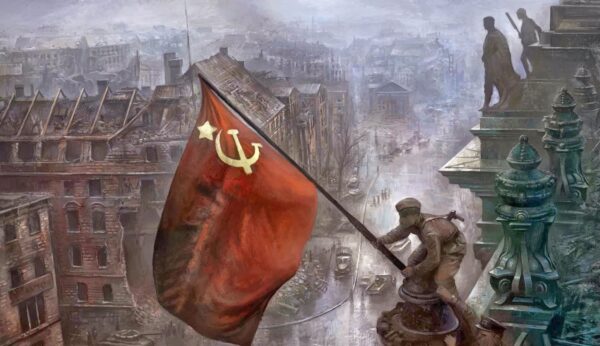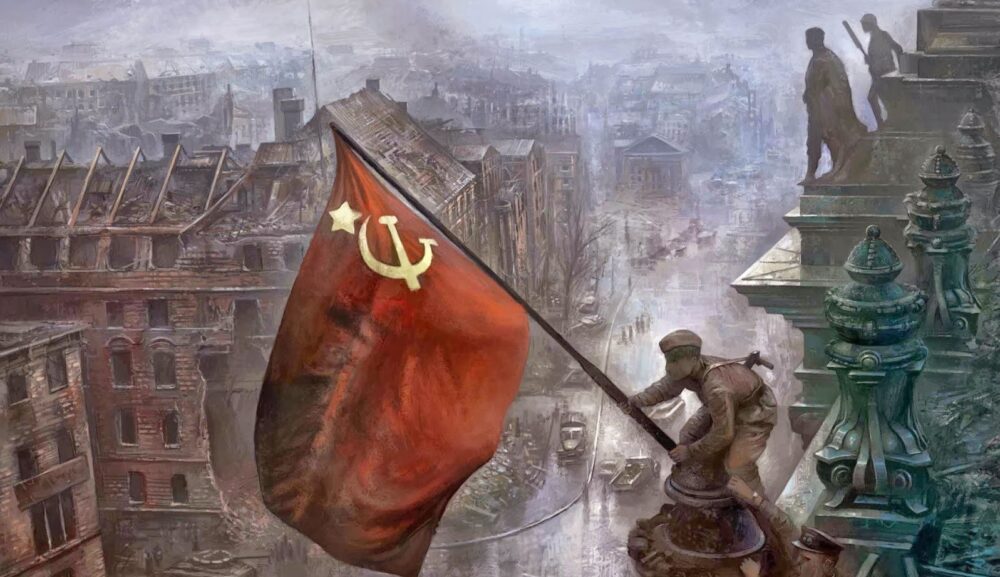Friday 8th May marks the 75th anniversary of the end of the Second World War in Europe
Paddy Meehan Socialist party (ISA in Northern Ireland)
In the midst of the Covid-19 lockdown, the establishment are appealing to the ‘Blitz spirit’ and the sense that we’re all in it together against a common enemy. These appeals are as empty now as they were in the midst of the horrors of fascism and war.
Over 70 million people would lose their lives in the Second World War — including 6 million Jews, 4.7 million Poles and 4 million socialists, homosexuals, Romany gypsies and other ‘undesirables’ who met their end in the Nazi death camps.
Names like Auschwitz-Birkenau, Belsen and the Warsaw Ghetto would be imprinted on popular consciousness as the horrors of fascism that must never happen again. Yet many will ask why such a conflict was allowed to happen again within a generation of the slaughter of the First World War.

World War I ended by revolutionary wave
The First World War marked the first industrial scale military conflict, with bloody slaughter on the Western and Eastern fronts. It was also the first major conflict of imperialist, capitalist powers over control of world markets. The conflict had been fought to a stalemate when workers, soldiers and sailors rose up, first in the Russian revolutions and later in Germany. These revolutions put an end to the war but, except in Russia, capitalism remained in place.
German capitalism was defeated and subjected to significant reparations and annexations. Britain and France emerged with their empires intact, but heavily in debt to the rising power of the US, yet to attain its future status as the dominant capitalist power in the world. The precedent set by the October Revolution and the creation of the world’s first workers’ state in Russia meant that the so-called armistice was merely a shift of conflict from western Europe into the Russian Civil War, the suppression of revolutionary movements at home and the brutal maintenance of colonies around the world.
All the issues of imperialist conflict, the battle over control and access to markets and colonies for the benefit of national capitalist classes, would undoubtedly come to the fore again. With the added threat globally of a growing opposition to the capitalist system in the form of significant strikes and uprisings — from Minneapolis to Glasgow, Berlin to Shanghai — capitalism had to deal with its own competing national elites and a very real threat from an increasingly organised and radicalised working class.
Any ability of capitalism to provide a way forward was utterly destroyed at the cusp of the 1930s, when the global economy nose-dived into depression after the 1929 crash. The struggle of capitalists to maintain their profits and control over the resources and workplaces led them to increasing the poverty and misery of workers. The last throw of the dice for the system would be to resort to fascist dictatorship in Germany and Italy, with the smashing of organised working-class resistance to their policies.
The rise of fascism and capitalism’s response
The commemorations in Britain have portrayed the war effort as a national campaign involving all classes to defeat the evils of Hitler and fascism. However, the response of the British ruling class to fascism was, at best, a limited opposition with a view to defending their imperial possessions and, at worst, an active sympathy for the aims of fascism to smash opposition and clear the way for capitalism to make huge profits. The abdicated King Edward VIII had such a close relationship with the Nazis after the occupation of France in 1940 that he was able to ask the occupying forces for guards to be posted at his French homes.
The British ruling class’s response to fascism in the 1920s and 30s was appeasement, spearheaded by Chamberlain, now much reviled. They favourably looked upon Mussolini’s rise to power in Italy. On a visit to the country in 1927, Churchill said, “If I had been an Italian, I am sure I should have been wholeheartedly with you from the start to finish in your triumphant struggle against the bestial appetites and passions of Leninism.”
This same sentiment explains why they stood idly by in the Spanish Civil War. Indeed, as the war neared its end, Churchill would order the drawing up of plans to simply decapitate the Nazi regime but keep it broadly intact, and launch a new offensive against the Soviet Union, whose alternative economic and social system, albeit grossly degenerated, he opposed in a much more genuine way than he opposed fascism.
These plans, however, were unrealisable both for military reasons and because of the resistance they would have faced from the workers across the world.
Appeasement and embrace
The logic of appeasement was that the key danger to British capitalist interests was not fascism but the threat of revolution and the potential role that the Soviet Union could play, representing an alternative to capitalism, albeit grossly deformed. The decline of the British empire meant any conflict in Europe would weaken their ability to control dominions and strengthen the hand of US capitalism internationally. When a thuggish, anti-socialist/Soviet strong man came along with ambitions to spread German power in central Europe and the Balkans, they jumped at the chance to act as mediator over German rearmament and annexations. Nazi occupation of Austria and Czechoslovakia was permitted in exchange for a commitment not to disturb British imperialist interests.
The German capitalists had already come to terms with the need for a dictator. The 1920s in Germany saw not one but many revolutionary upheavals and, by the 1930s, a strong labour movement remained in place despite the capitulation of the leaders of the reformist SPD. The growth of a significant German Communist Party — albeit one tied to the self-interested zigzags of the Soviet bureaucracy — made German capitalism seek the support of a growing movement of the ruined middle classes, increasingly consolidated around the Nazi Party and Hitler himself. A minority of the German business class — such as Thyssen, Bosch and Thiele — actively and financially supported the Nazis early on. However, the crisis posed by the capitalist crash and the growing militancy of German workers meant these initial supporters started to introduce Hitler and the Nazi leadership to wider sections of German capitalism and the state as a potential alternative.
German workers could have stopped Hitler
It was at this stage that Hitler and the Nazis could have been stopped. The German working class still retained huge organisations and power, despite the political weakness of their leaderships. A united front approach which recognised the real dangers fascism posed, as argued by Trotsky, could have brought down the system and prevented the inevitable position that German capitalism, under threat, would turn to fascism to smash these organisations.
Ultimately, the failed policy of the SPD leadership of backing up the German state and the sectarian, Stalin-inspired line of the German Communist Party failed to recognise this danger. Due to this failure of leadership, the only force capable of stopping the horror that was to come — the organised and active working class — was smashed in the Nazi consolidation of power.
Spanish Civil War
Instead, the push to a new global conflict accelerated through the 1930s. The Spanish Civil War, which acted as a very prescient precursor to the World War, saw re-armed Germany and Italy testing their murderous policies while intervening to back Franco. It saw the inaction of the British, French and American states who — fearful of the development of socialist forces in western Europe — officially didn’t intervene to stop fascism but, in reality, passively accepted it. All the while, Stalin’s intervention was deliberately inadequate, so as not to upset his reticent future allies in Britain and the US. And so the Spanish revolution and the Spanish working class and peasantry were sacrificed.
These events would also show another side of the coming world war. Tens of thousands of men and women from around the world would travel to defend the Spanish Republic. Their actions would be echoed in the resistance movements that developed in occupied France, Italy, Poland, Greece, the Balkans, Vietnam and China, with socialist and communist workers and youth playing a prominent role. Millions of workers around the world saw the necessity to defeat fascism by fighting and contributing to the war effort, despite devastating sacrifices.
This sacrifice would be very distinct from the ruling elites. In Britain, Churchill would bungle a defence of western Europe and fight a war aimed at defending the British Empire. Long a proponent of delaying the Allied invasion of western Europe, he would prefer a disastrous heavy bombing campaign which became increasingly indiscriminate. While Stalin would push for Western alliances against Hitler, they would be rebuffed. He shifted tack and aligned with Hitler in the Molotov-Ribbentrop Pact. This was not used to buy time to prepare for the inevitable invasion. Stalin believed Hitler’s assurances and participated in the brutal carve up of Poland, all the while weakening the basis of the Red Army and workers to fight back through purges and lack of preparation.
Hitler’s advance and Soviet resistance
Hitler and the Axis powers would embark on a lightning war taking Manchuria, Belgium, the Netherlands, France, and significant sections of the Balkans in a few short years. Hitler would then turn his attention to the Soviet Union and, in June 1941, launched the largest invasion in all human history. The brutality of the Nazi invasion of eastern Europe and the Soviet Union would make clear to the entire Soviet population this was to be a war of annihilation.
The Stalinist bureaucracy, shocked and unprepared, would see the necessity of loosening their control to ultimately save their own skins. Aspects of the purges would be relaxed and, particularly in the Red Army, a freer hand was given to prepare the defence of the Soviet Union. This was coupled with an attempt to de-politicise the conflict — the labelling of the conflict as a “Great Patriotic War”, with no appeal to German workers and conscripted soldiers, and the re-introduction of high-level military ranks. After the initial crushing defeats of the early part of the invasion, the heroic sacrifice (over 27 million Soviet soldiers and civilians were killed) and unmatched war effort (the T-34 tank was the most produced tank of the war) would push the Nazis back to Berlin and result in the Red Army occupying territory across eastern Europe and Germany.
Blitz spirit?
One myth consciously pushed is that everyone was ‘all in this together’ when it came to the war effort. Like today, the reality was much different. In London’s East End, working-class communities had to fight for underground bomb shelters. Despite the wishes of trade union leaders and even the Stalinised Communist Party, they could not stop workers taking action to defend their interests.
In 1944, Belfast saw engineering workers strike, demanding higher wages. As factory after factory came out, this developed into a general strike of the engineering industry. By the end of March, over 20,000 workers were out. Similarly, in 1942, a strike developed in Shorts against attempts to fire two trade unionists. On both occasions, the initiative came from the trade union ranks, with both the organization and the coordination of the action being carried out by the powerful shop stewards’ organisations.
Post-war carve up
The Yalta and Potsdam conferences saw the coming together of the major imperialist powers — America, Britain — alongside the Stalinist USSR in order to carve the world into ‘spheres of influence’. This was important in order to cut across the resistance movement opposing Nazi occupation, which posed the question of workers taking on the running of society. In particular, movements were erupting in Greece, France and Italy. The conferences consolidated America’s dominant position as the major power in the capitalist world at the expense of the old powers — Britain in particular. The capitalists were only able to hold on to their system on the basis of massive concessions to workers, including in Britain, where workers won the creation of the NHS and nationalisation of sectors of the economy.
Lessons for today
The period is full of lessons for today, most obviously about the dangers of the workers’ movement not confronting fascists attempting to organise. The period after the war was one where workers were able to win massive victories which we still have to defend today from those who seek to destroy these gains. Crucially, for socialists, it was not Churchill or Stalin who were key to defeating fascism, but the heroic efforts of ordinary working-class people. Neither then nor now are we ‘all in it together’. There were sharp differences between the interests and attitudes of the capitalist elite and those of workers. The defeat of fascism was built on the spirit of sacrifice and solidarity of the working class. Workers have saved humanity against some of the most brutal dictatorships ever seen. They have changed the course of history, and they can do so again.




